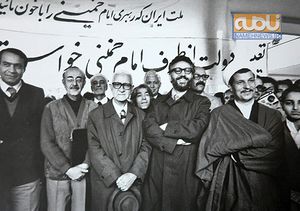إبراهيم يزدي
| ابراهيم يزدي | |
|---|---|
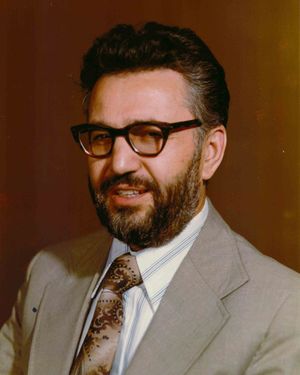
| |
| يزدي عام 1979 | |
| عضو البرلمان الإيراني | |
| في المنصب 28 مايو 1980 – 28 مايو 1984 | |
| الدائرة الانتخابية | طهران والري وشميرانات وإسلامشهر |
| الأغلبية | 1,128,304 (52.9%) |
| وزير الشؤون الخارجية الإيرانية | |
| في المنصب 12 أبريل 1979 – 12 نوفمبر 1979 | |
| رئيس الوزراء | مهدي بازرگان |
| سبقه | كريم سنجابي |
| خلفه | أبو الحسن بني صدر |
| نائب رئيس وزراء الشؤون الثورية الإيرانية | |
| في المنصب 13 فبراير 1979 – 12 أبريل 1979 | |
| رئيس الوزراء | مهدي بازرگان |
| خلفه | مصطفى چمران |
| تفاصيل شخصية | |
| وُلِد | 26 سبتمبر 1931 قزوين، إيران |
| توفي | 27 أغسطس 2017 (aged 85) إزمير، تركيا |
| القومية | إيراني |
| الحزب |
|
| الزوج | سوران طالعي[1] |
| الأنجال | 6 |
| الجامعة الأم | جامعة طهران جامعة بايلور |
ابراهيم يزدي (فارسية: ابراهیم یزدی؛ 26 سبتمبر 1931[2][3] – 27 أغسطس 2017)، هو سياسي ودبلوماسي إيراني خدم كنائب رئيس وزراء ووزيراً للشئون الخارجية في حكومة مهدي بازرگان الانتقالية، حتى استقالته في نوفمبر 1979، في الاحتجاجات التي وقت أثناء أزمة الرهائن الإيرانية. من 1995 حتى 2017، ترأس حركة الحرية الإيرانية.
الحياة المبكرة والتعليم
وُلد يزدي في قزوين في 26 سبتمبر 1931.[4][5] درس الصيدلة في جامعة طهران.[5] ثم حصل على الماجستير في الفلسفة من جامعة طهران.[6]
بعد الانقلات العسكري عام 1953، والذي أطاح بحكومة محمد مصدق، انضم يزدي حركة المقاومة الوطنية الإيرانية السرية، وكان عضواً نشطاً في التنظيم من 1953 حتى 1960. كان هذا التنظيم معارضاً للشاه، محمد رضا بهلوي. سافر يزدي إلى الولايات المتحدة عام 1961[7] لمواصلة تعليمه هناك، واستمر في النشاط السياسي المنهاض للشاه.
كان عضواً مؤسساً لحركة الحرية الإيرانية، في الخارج، برفقة مصطفى چمران، علي شارياتي وصادق قطبزاده عام 1961. كانوا جميعاً جزء من الجناح الخارجي الراديكالي للمجموعة.[8] عام 1963، ذهب يزدي، چمران وقطب زاده إلى مصر والتقوا بالسلطات لتأسيس تنظيم مناهض للشاه في البلاد، والذي أطلق عليه لاحقاً SAMA، تنظيم خاص للوحدة والحراك.[8] تم اختيار چمران كرئيس عسكري للتنظيم قبل عودته للولايات المتحدة.[8] عام 1966، نقل يزدي المقر الرئيسي لSAMA إلى بيروت.[8] عام 1967، التحق بجامعة بايلور وحصل على الدكتوراه في الكيمياء الحيوية.[6]
عام 1975، حوكم يزدي غيابياً في المحكمة العسكرية الإيرانية وحكم عليه بعشر سنوات، وصدر أمر بالقبض عليه عند عودته إلى إيران. بسبب أنشطته، كان غير قادراً على العودة لإيران وظل في الولايات المتحدة حتى يوليو 1977.[6] حصل على الجنسية الأمريكية في هيوستن 1971.[7] عندما انتقل آية الله خميني من العراق إلى باريس عام 1978، انتقل كذلك يزدي وبدأ العمل كمستشار لآية الله.[9] كان يزدي أيضاً متحدثاً رسمياً للخميني في باريس.[7]
الأنشطة المهنية والسياسية
عمل يزدي كباحث مساعد في علم الأمراض وباحث مدرس في علم الصيدلة بكلية الطب بجامعة بايلور في هيوستن حتى 1977.[6] عمل كذلك في المستشفى الإداري للمحاربين القدماء في هيوستن.[6]
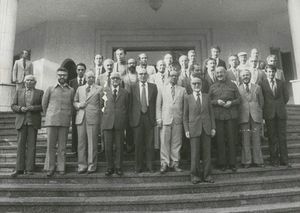
عام 1978، انضم يزدي لآية الله في باريس حيث كان الأخير هناك في منفاه وأصبح واحداً من مستشاريه.[10] كان يزدي يترجم التقارير للخميني إلى اللغة الإنگليزية في مؤتمر صحفي في مؤتمر صحفي عقد في طهران في 3 فبراير 1979.[11] كان نائباً لرئيس الوزراء ووزيراً للشئون الخارجية في الحكومة الانتقالية تحت رئاسة مهدي بازرگان، حتى 6 نوفمبر 1979.[12] اقترح يزدي الاحتفال "بيوم القدس" وحاز اقتراحه على اعجاب الخميني في أغسطس 1979.[12] في مايو 1980، عينه الخميني رئيساً لجريدة كيان.[13]
في 4 نوفمبر 1979، تم الاستيلاء على السفارة الأمريكية للمرة الثانية، من قبل مجموعات تطلق على نفسها "طلاب على خطى الإمام (مثل آية الله الخميني)" وتحت قيادة محمد موسوي خوينيها، الذي كان مقرباً من قادة الثورة.
As before, Yazdi was asked to go to the embassy and resolve the crisis. He asked and received permission of Khomeini to expel the occupiers, but shortly thereafter found out Khomeini had changed his mind[14] and appeared on state television openly endorsed the takeover of the embassy. The entire cabinet of the interim government, including Yazdi and Prime Minister مهدي بازرگان، resigned in protest the next day. They stated that they opposed the embassy takeover as “contrary to the national interest of Iran”.
The embassy takeover is considered to have been motivated in part by an internal struggle between various factions within the revolutionary leadership, with Yazdi and Bazargan on one side, and more radical clergy on the other. The embassy attackers, in subsequent statements indicated that one of their primary objectives in the takeover of the US embassy in November 1979 was to force the resignation of Yazdi, Bazargan, and the entire cabinet.[بحاجة لمصدر]
Among the areas of conflict between the two factions was the behavior of the Revolutionary Courts and the Revolutionary Committees. Yazdi and Bazargan supported a general amnesty for all members of the Shah’s regime, provided that they cease to act against the revolution. They publicly opposed the secret trials and the summary executions carried out by the Revolutionary Courts, led by Ayatollah Sadegh Khalkhaali. Bazargan and other members of the interim government called for fair and open trials for those accused of crimes committed under the Shah’s regime. The radical clerics, on the other hand, stated that the rapid trials and executions were essential to protect the revolution.
After resignation from office, Yazdi and other members of the Freedom Movement of Iran ran in elections for the first post-revolutionary Islamic Consultative Assembly or parliament. Yazdi, Bazargan, and four other members of the Freedom Movement, namely Mostafa Chamran, Ahmad Sadr, Hashem Sabbaghian, and Yadollah Sahabi, were elected. They served at the parliament from 1980 to 1984.
After the Iraqi invasion of Iran in September 1980, Yazdi fully supported the Iranian war effort against the invasion, but opposed the continuation of the war after the Iranian victory in Khorramshahr in 1982. The war continued for an additional six years. During these six years, Yazdi and others in the Freedom Movement issued several open letters to Ayatollah Khomeini opposing the continuation of the war. These letters and other public statements resulted in the firebombing of Yazdi’s residence in Tehran in 1985, and the arrest and imprisonment of several member of the Freedom Movement.
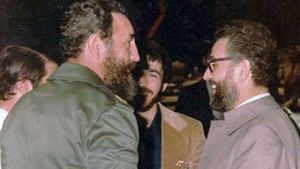
In subsequent elections in Iran for president, parliament, and city councils, Yazdi and other members of the Freedom Movement filed for candidacy but were barred from running by the Guardian Council, because of their opposition to policies and actions of the government.[15]
In December 1997, Yazdi was arrested on unknown charges and detained in Evin prison in Tehran. Even after his release, he was barred from leaving the country for many years, and summoned on a regular basis to answer questions before the revolutionary council, with his lawyer, Nobel Prize–winning Shirin Ebadi. As of 2008 Yazdi is still accused of “attempting to convert the rule of velaii (jurisprudence) into democratic rule.”
After the death of Bazargan in January 1995, Yazdi was elected as leader of Freedom Movement of Iran. Under pressure from the revolutionary court prosecutor, Yazdi offered his resignation as FMI Leader from on 20 March 2011 to the leadership council of the FMI. They have yet to accept his resignation and Yazdi continues to function as the leader of the Freedom Movement of Iran.
سنواته اللاحقة ووفاته
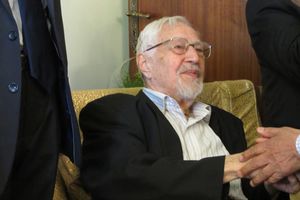
توفي إبراهيم اليزدي يوم 27 أغسطس 2017 في إحدى مستشفيات مدينة إزمير بتركيا حيث كان يعالج من سرطان البنكرياس، وذلك عن عمر يناهز 85 سنة.[16]
أعمال مختارة
Aakhareen Talaash-ha Dar Aakhareen Rooz-ha (Final Efforts, Final Days), Qalam Publications, 1984 (13th Edition, 1999) (a report and analysis on the Iranian Islamic Revolution of 1979)
Principles of Molecular Genetics (Third Edition), Ettela’aat Publications, Tehran, 2000
Mutational Changes in Generic Materials, Matin Cultural Foundation, Tehran, 1986
Seh Jumhuri (The Three Republics), Jaameye Iranian Publications, 2000 (a compilation of political essays and articles by Ebrahim Yazdi published in Iranian journals from 1997–2000)
Khatti Dar Darya (A Line in the Sea), Qalam Publications, Tehran, 2000 (a new interpretation of the verse of the Quran on “Marajul Bahrain”)
Khaak-haa-ye Rosi va Paydaayesh-e Hayaat (Clay Minerals and the Origin of Life), Qalam Publications, 2001 (a new interpretation of the verses of the Quran on “Teen-e Laatheb”)
Kalbod Shekaafee-ye Towte-e: Barresee-ye Kudetaa-ye Beestohasht-e Mordaad 1332 (The Anatomy of a Plot: An Analysis of the Coup of August 1953), Qalam Publications, 2002 (a collection of essays on the US and British led military coup against the national government of Mohammad Mossadegh)
Docterin-e Amniyyat-e Melli (National Security Doctrine), Sarai Publications, Tehran, 2004 (a compilation of political essays on Iranian foreign affairs from 1980–2004)
Jonbesh-e Daaneshju-yi-e Iran 1320-1340 (The Iranian Student Movement from 1941–1961), Qalam Publications, 2004 (a history and memoirs of the student movement and activities of Ebrahim Yazdi during this period)
المصادر
- ^ انتقال ابراهیم یزدی به خانه امن وزارت اطلاعات
- ^ Profile of Ebrahim Yazdi
- ^ http://www.bbc.com/persian/iran-features-38251486
- ^ Houchang E. Chehabi (1990). Iranian Politics and Religious Modernism: The Liberation Movement of Iran Under the Shah and Khomeini. I.B.Tauris. p. 228. ISBN 978-1-85043-198-5. Retrieved 27 August 2013.
- ^ أ ب Ibrahim Yazdi Gale Encyclopedia of the Mideast and N. Africa
- ^ أ ب ت ث ج "Rescue leader at embassy was researcher at Baylor". Toledo Blade. Houston. AP. 14 February 1979. Retrieved 13 August 2013.
- ^ أ ب ت "Official of Iran is a US citizen". The Milwaukee Sentinel. 15 March 1979. Retrieved 13 August 2013.
- ^ أ ب ت ث Houchang Chehabi; Rula Jurdi Abisaab; Centre for Lebanese Studies (Great Britain) (2 April 2006). Distant Relations: Iran and Lebanon in the Last 500 Years. I.B.Tauris. p. 182. ISBN 978-1-86064-561-7. Retrieved 8 August 2013.
- ^ Rubin, Barry (1980). Paved with Good Intentions (PDF). New York: Penguin Books. p. 220.
- ^ Zonis, Marvin (July 1983). "A Theory of Revolution From Accounts of the Revolution". World Politics. 35 (4): 586–606. doi:10.2307/2010391. JSTOR 2010391.
- ^ Sahimi, Mohammad (3 February 2010). "The Ten Days That Changed Iran". PBS. Los Angeles. Retrieved 30 July 2013.
- ^ أ ب Ardalan, Siavash (1 August 2013). "Iran's 'Jerusalem Day': Behind the rallies and rhetoric". BBC. Retrieved 13 August 2013.
- ^ "Khomenei's hard-liners triumph". The Spokesman Review. AP. May 1980. Retrieved 4 August 2013.
- ^ Bowden, Guests of the Ayatollah, (2006) p. 93
- ^ "Human Rights and Parliamentary Elections in the Islamic Republic of Iran". Human Rights Watch. 8 (1). March 1996. Retrieved 27 August 2013.
- ^
{{cite web}}: Empty citation (help)
المراجع
- J D Stempel, Inside the Iranian Revolution, Indiana Univ Press, 1981
- Sadegh Khalkhali, Khateraateh Khalkhaali (Memoirs of Khalkhaali), Sayeh Publications, Tehran, 2003
- Abdolali Bazargan, ed, Moshketaal va Masa’ele Av’valeen Saale Enghelaab Az Zabaane Mohandes Bazargaan (Issues of the First Year of the Revolutions as Explained by Mehdi Bazargan), Tehran, 1981
| مناصب سياسية | ||
|---|---|---|
| سبقه كريم سنجابي |
وزير خارجية إيران 1979 |
تبعه صادق قطبزاده |
| مناصب حزبية | ||
| سبقه مهدي بازرگان |
أمين عام حركة حرية إيران 1995–2017 |
تبعه سيُعلن |
| سبقه عباس أمير-انتظام |
رئيس المكتب السياسي في حركة حرية إيران 1979–1995 |
تبعه محمد توسلي |
- CS1 errors: empty citation
- Articles containing فارسية-language text
- Articles with unsourced statements from July 2011
- مواليد 1931
- وفيات 2017
- أشخاص من قزوين
- خريجو جامعة طهران
- خريجو جامعة بيلر
- سياسيو حركة الحرية الإيرانية
- أشخاص في الثورة الإيرانية
- نواب طهران والري وشميرانات وإسلامشهر
- وزراء خارجية إيران
- سجناء ومعتقلون إيرانيون
- ثوريون إيرانيون
- إيرانيون مغتربون في الولايات المتحدة
- Members of the 1st Islamic Consultative Assembly
- إيرانيون مغتربون في فرنسا
- أشخاص حصلوا على الجنسية الأمريكية
- أعضاء مجلس الثورة الإسلامية
- ممثلو المرشد الأعلى في معهد كايهان
- أمناء عموم أحزاب إيران
- سياسيو الجبهة الوطنية (إيران)
- وفيات بالسرطان في تركيا
- وفيات بسرطان البنكرياس
